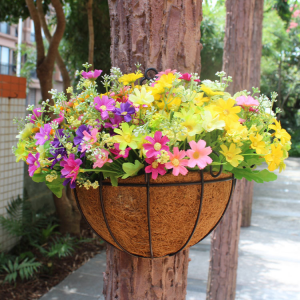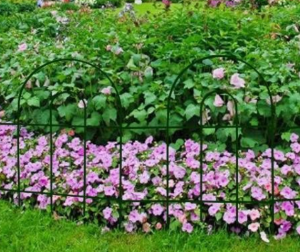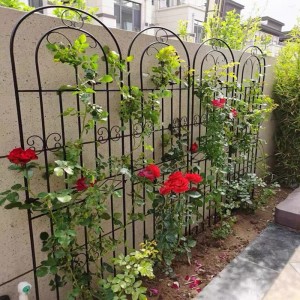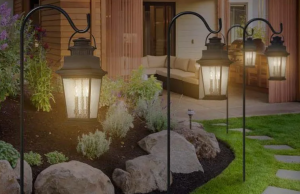1. Use Ornaments as Finishings
Much more than an afterthought, garden ornaments can guide how you shape and use your outdoor space, and affect how it feels when you’re in it. A wrought-iron gate can mark the entrance to a world of green, a tree-hung lantern raise your perspective, a curved bench inspire a nap. Carefully placed, pretty yet practical, these elements offer subtle but effective clues: Turn here. Look up. Slow down. They also give a garden space a finished look in all four seasons. The trick is to not overdo it.
Shown: A weathered iron pendant, with some bulbs removed for a moody glow, hangs from a tree over a bed of agaves.
2. Design for Outdoor Rooms
“A furnished garden shouldn’t look too perfect or contrived,” says Susie Beall, an interior designer who, with her architect husband, Ed, conceived the gardens on their rolling acre in Southern California. Their goal: to create outside rooms as comfortable as the ones inside.
Shown: Succulents spill out of a pillar-like planter at a path entrance, with an iron bell hanging from a nearby tree.
3. Don’t Be Afraid of Patina
Just as they remade their 1950s ranch house in the style of a Tuscan farmhouse, the couple wanted a landscape with patina. They started by adhering to a simple, mostly green palette of plants starring pepper, cypress, and Chinese elm trees amid rosemary, acanthus, Virginia creeper, and white ‘Iceberg’ roses. “Garden decor can get lost in a highly colorful landscape,” says Susie. “For us, our mostly stone ornaments are the busy part, and they pop against the green background.” Certain items, picked up on their travels, may be pedigreed and pricey, but they share ground with catalog and nursery finds, so nothing seems too precious. Read on to learn how they used decorative objects to create seductive outdoor living spots.
Shown: A lantern sits on a stone shelf, with a mirror providing a window onto the green world
4. Repeat Your Home’s Exterior Style
Whatever the style of your home, ornaments can carry it into the landscape, grounding the building in its setting. Here, to harmonize with the rustic stone-clad entry, iron urns are set atop matched terra-cotta pedestals. In the courtyard, a pediment decorated with dolphins and holding potted succulents echoes the theme and creates a focal point. The house’s stone is picked up in the pavers, seamed with grass that softens the walk to the front door.

5. Dress Up Garden Entrances
Even in a small landscape, a sequence of discrete spaces, connected by passageways and paths, adds a sense of mystery and expansiveness to an ordinary stroll. The Bealls created a journey that begins with a wisteria-draped arbor near the house and winds downhill, across terraces, along walks, and down steps that continue the theme of eye-catching, weatherworn stone. Paths indicate the way; iron arches and gates—many from gardener’s-supply catalogs and covered with vines—mark transitions to different areas. Potted bougainvillea, citrus trees, and palms further accent entries, as do finials perched on pedestals.
6. Tie Furnishings Into the Overall Scheme
The style of any tables and chairs you choose has a big impact on the look of your outdoor spaces, of course. But they should also feel cohesive with the other decorative objects and materials you use. The Bealls found a pair of inexpensive rust-finished iron dining sets at a pottery yard. With extra chairs scattered around the paved “carpet,” they make a casual lounge for cocktails and conversation.
7. Choose Decor Suited for The Outdoors
Elsewhere, the couple created an outdoor living room, but instead of pricey all-weather wicker, they chose roll-arm wicker chairs from an import store and weatherized them with spray-on marine varnish. Concrete pottery-yard pedestals double as extra seats and cocktail tables. A black oval aluminum dining set anchors the main gather-round eating space.
Post time: Jul-25-2022




